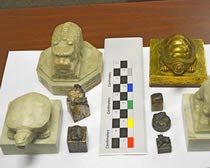Last week in San Diego, California, Homeland Security Investigations (HSI) of Immigration and Customs Enforcement (ICE) seized nine national and royal seals originating from the Korean Empire and the Joseon Dynasty. They are described in an ICE press statement as “invaluable to South Korea.” But the legal authority justifying the seals’ seizure remains unclear, requiring further explanation by ICE.
ICE reports, “The cultural artifacts were turned over to HSI special agents by the family of a deceased Marine lieutenant, who had served in the Korean War. The lieutenant had found the seals in 1950 in a ditch near the Deoksugung Palace, which had just been ransacked by Chinese and North Korean soldiers.”
ICE says that the seals were exported illegally to the United States. But an illegal export, by itself, would not be grounds to seize the seals. ICE mildly hints that this export may have triggered a violation of American law, but it is conceded that the agency does not explicitly cite the illegal export as a basis to seize the seals.
 |
| Korean seals seized by ICE in San Diego. |
ICE states more directly that the “seals were seized pursuant to [an] abandonment of property form ….”
Abandonment, which is the relinquishing of legal rights to property, is justification for a seizure because it is a renunciation of property interests. Abandonment permits another party like the federal government to assume those property interests (i.e. possession or title) provided there is lawful authority.
Abandonment is a persuasive legal justification for seizing the seals. So what remains unclear is ICE’s additional explanation justifying the seizure, what the agency claims is a “violation of the Cultural Property Implementation Act.” That is because the CPIA would not seem to have any legal authority in this case.
ICE states, “On Feb. 14, 1983, South Korea became a signature country to the 1970 United Nations Educational, Scientific and Cultural Organization (UNESCO) Convention on the Means of Prohibiting and Preventing the Illicit Import, Export and Transfer of Ownership of Cultural Property.”
South Korea may be a signatory to the 1970 UNESCO Convention, but that nation has no memorandum of understanding (also known as a bilateral agreement) with the U.S. The CPIA is the law that implements the 1970 UNESCO Convention in the U.S., and an MoU authorized by the CPIA is necessary before America can institute import restrictions to seize jeopardized cultural artifacts crossing into the U.S. There are no import restrictions to date. As a result, there appears to be no authority for ICE to seize the Korean seals under the 1970 UNESCO Convention or the CPIA.
Unless the seals were inventoried in and stolen from a museum during or after 1983 (and they were not according to the information supplied), South Korea’s adoption of the 1970 UNESCO Convention would bear no relevance on whether federal agents could seize the seals under authority of the CPIA.
In its press statement, ICE goes on to recite that “South Korea’s applicable cultural patrimony laws are the Korean National Property Act, enacted April 8, 1950 and the Korean National Property Act-Enforcement Decree, enacted June 10, 1950. According to the Korean National Property Act, the aforementioned seals fall under the category of Korean national property, which is illegal to transfer or export.”
While an assessment of these statutes would be relevant to whether U.S. law recognizes South Korea’s rightful ownership of the objects, the foreign statutes’ export regulations would be of no interest to American law since U.S. law only enforces American import restrictions, not foreign export controls.
In fact, ICE does not appear to base its seizure on the rationale that the seals were owned by South Korea and stolen from that country in violation of its patrimony laws. If the seals were characterized as stolen, they would likely have been taken by ICE under 19 USC § 1595a‘s “contrary to law” provision that allows federal authorities to seize stolen property brought into the U.S. and to return the property to the legal owner.
Perhaps ICE is using Korea’s patrimony law to support a claim that the now “abandoned” seals belong to South Korea. We do not know for sure.
A clearer legal explanation of what happened in the current South Korean case would help attorneys, collectors, auction houses, museums, preservationists, and other stakeholders better understand the federal government’s cultural property enforcement actions.
Photo credit: ICE
This post is researched, written, and published on the blog Cultural Heritage Lawyer Rick St. Hilaire at culturalheritagelawyer.blogspot.com. Text copyrighted 2010-2013 by Ricardo A. St. Hilaire, Attorney & Counselor at Law, PLLC. Any unauthorized reproduction or retransmission of this post is prohibited. CONTACT INFORMATION: www.culturalheritagelawyer.com
©2010-2022 Cultural Heritage Lawyer Rick St. Hilaire. Content discussing cultural heritage law, art law, looted antiquities, stolen artifacts, and museum risk management that is general information only, not legal advice.


